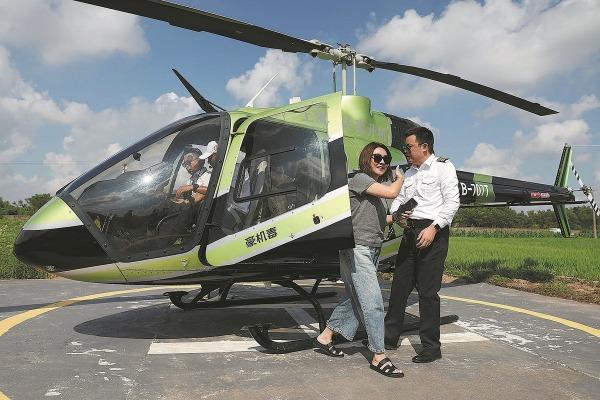Shanghai low-altitude economy soars: From citywalk to cityfly

Shanghai is embracing the sky, especially with its burgeoning low-altitude economy which is really taking off in various sectors, from tourism to transportation.
The city government's 2025 work report highlighted the potential of this expanding field and since then Shanghai has seen a surge in interest and activity in it.
Cityfly: New way to experience Shanghai
The new year ushered in a wave of "cityfly" experiences, with a growing number of residents and tourists choosing to explore Shanghai from above.
On New Year's Day, a social media influencer captured hearts with a scenic helicopter ride over the Huangpu River, garnering over 10,000 likes. During the Chinese New Year holiday, some 254 sightseeing flights carrying 508 passengers and 26 transportation flights carrying roughly 100 passengers took to the skies.
"Following the New Year's Eve chartered flight, a family booked a Bell 429 twin-engine helicopter on Chinese New Year's Eve to experience the city's skyline at night," said Cao Xintian, founder of Shanghai New Sky Helicopter.
More than just sightseeing
The city's growing fascination with aerial experiences is clear, given the success of companies like Shanghai New Sky Helicopter.
"We've been operating throughout the Chinese New Year holiday, offering scenic flights over the Huangpu River and the Bund," said Huang Jialei, a member of staff.
"We also offer flights over Disneyland at our Xingye flight base. It's a way to provide residents and tourists with a different perspective on the city," Huang added
A young man celebrating his 30th birthday called Qin, chose a scenic helicopter ride over the Huangpu River and the Bund, calling it an unforgettable experience.
The ride cost 2,980 yuan ($407.88) per person. Qin acknowledged the cost, but considered it as “good value for money” for a special experience rather than being inaccessible as he, like most of others, had thought. He described the view of the city's landmarks from above as truly breathtaking.
Low-altitude economy expands beyond leisure
The low-altitude economy, however, is not just about tourism. Shanghai is actively exploring its potential for transportation, particularly for short-haul commutes within the city and beyond.
"We're actively collaborating with districts to apply for urban air traffic management pilot programs," said Li Yang, deputy general manager of Shanghai New Sky Helicopter, referencing a recent government initiative.
"This will help us contribute to the development of commercial passenger urban air transport," he added.
"Last year, we were included in the Yangtze River Delta low-altitude passenger demonstration project, along with Linyang Aviation Technology".
The company aims to provide regular services to 45 districts and counties in the Yangtze River Delta region within the next three years. This will offer commuters direct flights from Pudong New Area to Minhang district – as well as from Kunshan in Jiangsu province and Haining and Shaoxing in Zhejiang province to Shanghai.
Shanghai New Sky Helicopter has already established nine regular low-altitude passenger routes, including Kunshan to Pudong.
"The price for the Kunshan-Pudong route was between 1,600 and 1,800 yuan last year, but we offered a discount price of 598 yuan per person during Spring Festival," Li said. "If it's well-received by the public, we'll keep the price for normal operations."
Addressing challenges: Noises and cost
While the low-altitude economy in Shanghai is taking off, it faces some distinct challenges. One significant obstacle is noise pollution.
"My neighborhood frequently hears loud helicopter noises," said a resident who preferred to be identified only by his surname, Fei.
"Developing the low-altitude economy requires addressing its impact on residents' lives, which necessitates strict environmental assessments and well-planned routes to minimize disruption," Fei added.
Li Yang acknowledged the noise concern, pointing to the recent opening of airspace over the Bund. "This allows helicopters to fly over the river, minimizing noise disruption for residents," he said.
“Flying above 200 meters also significantly reduces the impact on people on both sides of the river.”
Hong Baiyun, founder of the Miqi Flying Club, agreed that noise concerns need to be addressed. “In the early years, we did experience some resident complaints," he said. "However, by adjusting our flight routes and avoiding residential areas, we significantly reduced complaints."
While some residents might be concerned, others see the potential of low-altitude transportation, advocating its growth.
"Low-altitude economic activity primarily involves helicopters and drones," said a resident, surnamed Luan.
"Helicopters have defined routes, so the impact is minimal. As for drones, most are flown in open areas and above 100 meters, so the sound is barely audible," Luan added.
Another challenge is the high cost of air transport, which is hindering its wider adoption. "The cost of a single-engine helicopter is 20 million yuan, while a twin-engine helicopter can cost over 60 million yuan," Li said.
"The rise of the low-altitude economy has spurred the development of electric aircraft and within three years, we'll see the adoption of eVTOL –electric vertical take-off and landing – aircraft, reducing costs and eliminating fuel expenses."
The future of cityfly
Yue Tingting, vice-president of Vertaxi, a developer of innovative eVTOL aircraft, envisions a future where eVTOL transportation is as ubiquitous and convenient as taking a bus is today.
"We imagine a future where passengers can simply wait for 'air taxis' at eVTOL landing pads, just like waiting for a bus at a bus stop today," she said.
"The schedules will be frequent and efficient, just like today's city public transportation. There will be ample eVTOL landing sites throughout the city, making it both time-efficient and affordable for passengers to reach their destinations," Yue continued. "Air travel by eVTOL will become widely accepted and an integral part of the city's transportation network," she said.
This vision, however, requires a long-term strategy. "We aim to achieve point-to-point passenger flights by 2027, replacing some helicopter routes and eventually becoming a vital part of the city's transportation network," Yue added.
The transition to eVTOL, however, requires overcoming several hurdles – not the least, obtaining airworthiness certificates, establishing safety regulations and building public trust.
"Developing a cost-effective, safe and reliable eVTOL aircraft that meets global standards is critical," Yue said. "We also need to develop pilot certification and training programs, as well as comprehensive air traffic management systems."
Source: Youth Daily

